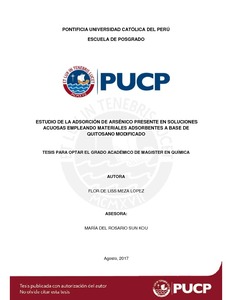| dc.contributor.advisor | Sun Kou, María del Rosario | |
| dc.contributor.author | Meza López, Flor de Liss | es_ES |
| dc.date.accessioned | 2017-09-29T22:03:37Z | es_ES |
| dc.date.available | 2017-09-29T22:03:37Z | es_ES |
| dc.date.created | 2017 | es_ES |
| dc.date.issued | 2017-09-29 | es_ES |
| dc.identifier.uri | http://hdl.handle.net/20.500.12404/9423 | |
| dc.description.abstract | La presente investigación tiene como objetivo principal el estudio de la adsorción de arsénico
empleando materiales adsorbentes a base de quitosano modificado. La importancia de este
estudio radica en la creciente preocupación por el impacto ambiental y el efecto negativo a la
salud generada por este contaminante debido su alta toxicidad a bajas concentraciones y a su
capacidad de bioacumulación. Los materiales adsorbentes se obtienen a partir del material
precursor quitosano (QUI). Con posteriores modificaciones realizadas al precursor, como la
incorporación del grupo carboxilo (COOH) formando el carboximetilquitosano (CMQ), la
funcionalización con Fe por impregnación mediante el método de oxidación in situ con un post
tratamiento tanto para el QUI como para el CMQ, se obtienen como materiales resultantes
Fe-QUI y Fe-CMQ. Los materiales adsorbentes son caracterizados mediante diferentes técnicas
instrumentales: RMN, FTIR, DRX, SEM, EDX, valoración potenciométrica, titulación Boehm y
pHPZC La estabilidad y el porcentaje de hierro impregnado también son evaluados. Los resultados
del estudio de adsorción muestran que los adsorbentes obedecen al siguiente orden:
Fe-CMQ > Fe-QUI > QUI >> CMQ, en base a la mayor capacidad de adsorción obtenida tanto para
la retención del As (III) y As (V). La evaluación de parámetros de adsorción (pH y masa de
adsorbente), demuestra que la adsorción de As (III) se favorece a pH 9 con una masa de 30 mg
de adsorbente, en tanto que para el As (V) la adsorción se favorece a pH 4 y con una masa de
20 mg, debido a la especiación que sufren ambos adsorbatos. Todos los resultados cinéticos se
correlacionan mejor con el modelo de pseudo segundo orden, evidenciando una interacción
adsorbato-adsorbente en base a la disponibilidad de sitios activos (interacción ácido/base y
electrostática). Así mismo, las isotermas de adsorción y los resultados en general muestran que
la adsorción se produce en centros activos con una superficie heterogénea y con una
distribución homogénea de energía. | es_ES |
| dc.description.abstract | The main objective of the present investigation is the study of the adsorption of arsenic with
adsorbent materials based on modified chitosan. The importance of this study lies in the growing
concern about the environmental impact and the negative effect on the health generated by
this pollutant due to its high toxicity at low concentrations and its bioaccumulation capacity.
The adsorbent materials are obtained from the precursor material chitosan (QUI). Subsequent
modifications made to the precursor, such as the incorporation of the carboxyl group (COOH) to
form the carboxymethylchitosan (CMQ), the functionalization with iron by impregnation and in
situ oxidation method with a post treatment for both QUI and CMQ, resulted in the materials
Fe-QUI and Fe-CMQ. The adsorbent materials are characterized by different instrumental
techniques: NMR, FTIR, XRD, SEM, EDX, potentiometric titration, Boehm titration and pHPZC.
Stability and percentage of iron impregnated are also evaluated. The adsorption study results
indicate that materials obey the following order: Fe-CMQ> Fe-QUI> QUI >> CMQ, based on the
higher adsorption capacity obtained for both retention of As (III) and As (V). The evaluation of
adsorption parameters (pH and adsorbent mass), shows that the adsorption of As (III) is favored
at pH 9 with a mass of 30 mg of adsorbent, whereas for As (V) the adsorption is favored at pH 4
and with a mass of 20 mg, due to the adsorbates speciation. All kinetic results are better
correlated with the pseudo second order model, evidencing an adsorbate-adsorbent interaction
based on the availability of active sites (acid / base and electrostatic interaction). Also, the
adsorption isotherms results in general show that the adsorption occurs in active centers with a
heterogeneous surface and with a homogenous distribution of energy. | es_ES |
| dc.description.uri | Tesis | es_ES |
| dc.language.iso | spa | es_ES |
| dc.publisher | Pontificia Universidad Católica del Perú | es_ES |
| dc.rights | Atribución-NoComercial-SinDerivadas 2.5 Perú | * |
| dc.rights | info:eu-repo/semantics/openAccess | es_ES |
| dc.rights.uri | http://creativecommons.org/licenses/by-nc-nd/2.5/pe/ | * |
| dc.subject | Quitosano | es_ES |
| dc.subject | Arsénico | es_ES |
| dc.subject | Adsorción | es_ES |
| dc.subject | Soluciones acuosas | es_ES |
| dc.title | Estudio de la adsorción de arsénico presente en soluciones acuosas empleando materiales adsorbentes a base de quitosano modificado | es_ES |
| dc.type | info:eu-repo/semantics/masterThesis | es_ES |
| thesis.degree.name | Magíster en Química | es_ES |
| thesis.degree.level | Maestría | es_ES |
| thesis.degree.grantor | Pontificia Universidad Católica del Perú. Escuela de Posgrado | es_ES |
| thesis.degree.discipline | Química | es_ES |
| renati.advisor.dni | 10831187 | |
| renati.discipline | 531057 | es_ES |
| renati.level | https://purl.org/pe-repo/renati/level#maestro | es_ES |
| renati.type | http://purl.org/pe-repo/renati/type#tesis | es_ES |
| dc.publisher.country | PE | es_ES |
| dc.subject.ocde | https://purl.org/pe-repo/ocde/ford#1.04.00 | es_ES |






